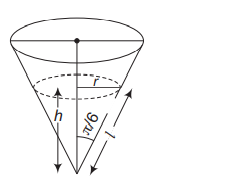Q. Water is dripping out at a steady rate of $1\, cm ^3 / s$ through a tiny hole at the vertex of the conical vessel, whose axis is vertical. If the slant height of water in the vessel is $4\, cm$, then the rate of decrease of slant height, where the vertical angle of the conical vessel is $\frac{\pi}{3}$, is
Application of Derivatives
Solution:
